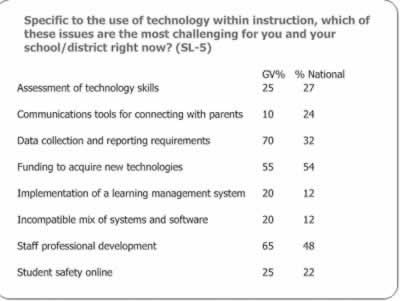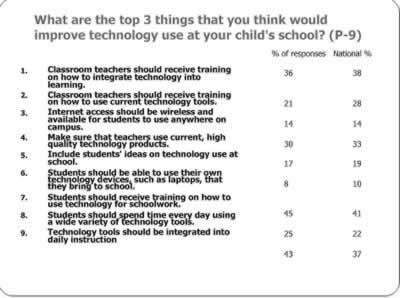One school district changed the standard in professional development; and it did so with a ‘Technology Academy.’
eSchool News provides not only daily original content on the latest in technology and innovation in education, but it is a trusted resource for teachers and administrators on how to implement technology to improve learning and enhance the student experience.
Our webinars, professional development, Educator Resource Centers, and best practices feature helpful tips for educators. The following story is one specific example of how to train teachers with the latest edtech tools.
Imagine you need to learn how to fly a jet. You’re given a link that describes how and an online video tutorial…nervous? Now imagine you’re being taught by a fighter pilot in a small class, and that class is with your peers. The course runs for weeks and includes experience from other teachers who now fly jets and were once like you. Little less nervous? Welcome to one district’s Technology Academy for teacher training.
Though it’s not a likely chance that any teachers are also pilots at Garnet Valley School District in Pa., for many teachers in schools across the country, the thought of knowing how to effectively use technology in classrooms is still an intimidating concept.
According to Paul Sanfrancesco, director of technology for the district, many teachers see technology as something that’s being pushed onto them. But once teachers learn the true value of education technology, the mindset can quickly change.
“The more you link the technology to the curriculum, the easier teachers find it—the less scary it will become—because it’s less of a foreign object and more a tool to help them instruct,” Sanfrancesco explained.
The problem for Garnet Valley was how to train teachers effectively in education technology without additional funds. Another concern was what to train teachers to use, since technology is constantly changing.
(Next page: Where to start?)
“What’s important to understand is that even these thoughts started just by simply walking around and developing relationships with people—teachers, administrators, principals and staff,” said Sanfrancesco. “Just strike up a conversation when possible and ask ‘What are the issues you’re having?’ What are your needs?’”
He continued: “When you have a comfort level with teachers it becomes less of a suspicious ‘Who is that administrator and why is he here?’ Teachers want to tell you what’s going on and what they need, but you have to have that relationship first.”
Sanfrancesco also noted that it’s important to have a similar relationship with central administration and the school board, because without buy-in and trust, ideas like the Technology Academy might never have existed.
Another large aspect of inspiration for the district was through their participation in Project Tomorrow’s Speak Up survey, which polls district staff, administration, community, students and parents on current issues in education.
After reading the results of the survey, Garnet Valley received startling data: The largest issue the district faced was in Professional Development; specifically, training teachers on technology:
“That was a large wake-up call for us,” exclaimed Sanfrancesco.
Turning data into action
Armed with three important tools to present to the school board—understandable data, building needs, and a realistic technology plan—Sanfrancesco received buy-in during a planned retreat from administration and the school board on a vision that become known as the Technology Academy.
The Academy is one week during the summer to train teachers on technology using other teachers as coaches. Sanfrancesco chooses the teacher coaches through recommendations made by school principals. Each school has a teacher coach in the Academy.
The teacher coaches, explained Sanfrancesco, are classroom teachers who volunteer to coach without any additional pay—a decision supported by the teacher’s union. To make up for lack of additional pay, teachers are granted whatever technology they wanted for the classroom.
Teacher coaches are also given the freedom to design the Academy’s structure. Teachers selected to be coaches met with Sanfrancesco from January to June in 2007 to go over planning the first Academy, as well as any additional instruction needed to become a coach.
(Next page: Funding and course design)
Sanfrancesco also helped secure partnerships for the Academy, includingSMART, Dell, Apple, Neumann University and Delco Solutions.
Neumann University charges the district a flat rate for an unlimited amount of credits, allowing the district to provide teachers participating in the Academy as attendees with three graduate credits or professional development credits.
A keynote speaker is also chosen to address the Academy on the first day of sessions, and throughout the years has included many notable speakers from both the business sector as well as noted higher education professors.
Teachers interested in joining the Academy must first apply for the week-long training; however, all teachers interested are accepted.
The Academy, which divides teacher participants by school and grade/subject taught (not by knowledge-level) and lasts from 8 AM to 3 PM every day, is divided into a 4-class roster that every teacher cycles through. Afternoon time is designed specifically for peer collaboration.
“What made the Academy even remotely feasible in terms of budget was planning far in advance,” said Sanfrancesco. “The first Academy we held spanned once a week every summer for three years [2007-2010]. By spreading the Academy out, by not making it one giant hit, we were able to use the money already allotted in the district’s budget. And since it’s tied to staff development, it makes it even easier.”
Sanfrancesco explained that teachers not already in the Academy in year one could jump in any time throughout the three-year roll-out, since no session in the Academy really has an entry-level course.
“The idea of the Academy is to teach by doing,” explained one of the Academy’s first teacher coaches, Kevin Windsor, a fourth-grade teacher. “Though we explain the basics of the technology, we expect peers to help each other figure out other less challenging aspects of the technology.”
The technology chosen for the Academy, said Windsor, depends on what the teachers say they’d like to learn. Examples include SMART Boards, Student Response Systems, digital storytelling, video conferencing, movie-making, Google Education Apps, and iPads.
(Next page: Big results)
Besides lessening the anxiety of teachers, not only has attendance in the Academy jumped from 90 teachers in 2007 to 200 participants in 2010, the Academy now has 100 percent participation from all teachers in the district.
Business, community, and higher education partnerships continued outside of the Academy, and many teachers have created personal learning and communication learning communities online.
“So many projects and initiatives come out of the Academy,” concluded Sanfrancesco. “We now have a BYO high school, a new K-12 iPad curriculum initiative, a distance learning program, the use of Google Drive, new SMART Boards in many of the classrooms, new LCD projectors, new staff development initiatives throughout the year, and even general infrastructure improvements.”
For more information on Garnet Valley’s Technology Academy, sign up for free for edweb.net’s “Digital Decisions for Collaborative Learning” community and watch Sanfrancesco’s presentation.
- #4: 25 education trends for 2018 - December 26, 2018
- Video of the Week: Dealing with digital distraction in the classroom - February 23, 2018
- Secrets from the library lines: 5 ways schools can boost digital engagement - January 2, 2018





Comments are closed.